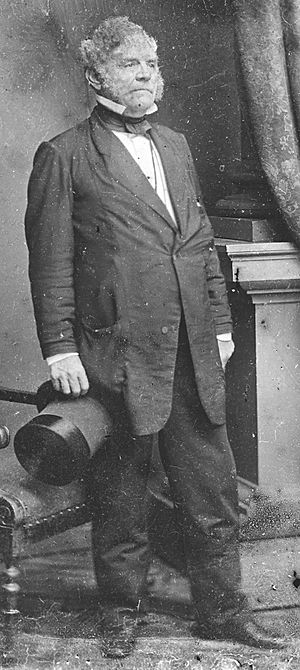Thomas Holliday Hicks facts for kids
Quick facts for kids
Thomas Holliday Hicks
|
|
|---|---|
 |
|
| United States Senator from Maryland |
|
| In office December 29, 1862 – February 14, 1865 |
|
| Preceded by | James A. Pearce |
| Succeeded by | John A. J. Creswell |
| 31st Governor of Maryland | |
| In office January 13, 1858 – January 8, 1862 |
|
| Preceded by | Thomas W. Ligon |
| Succeeded by | Augustus Bradford |
| Maryland House of Delegates | |
| In office 1829 – 1830, 1836 |
|
| Personal details | |
| Born | September 2, 1798 East New Market, Maryland, US |
| Died | February 14, 1865 (aged 66) Washington, D.C., US |
| Political party | Democratic (1830–1835) Whig (1835–1854) American (1854–1860) Constitutional Union (1860–1862) Unconditional Union (1862–1865) |
| Spouses |
|
| Children | 5 |
| National Governors Association, Governor's Information, Maryland Governor Thomas Holliday Hicks | |
Thomas Holliday Hicks (born September 2, 1798 – died February 14, 1865) was an important politician in Maryland during the American Civil War. Maryland was a "border state," meaning it was located between the Union (North) and the Confederacy (South) and had divided loyalties.
As governor of Maryland, Hicks had complex views. He supported slavery but did not want Maryland to leave the United States and join the Confederacy. He was pressured to call a special meeting of the state's lawmakers. He chose to hold this meeting in Frederick, a town that supported the Union. This decision helped keep Maryland from seceding.
In December 1862, Hicks became a U.S. Senator. He supported Abraham Lincoln's re-election as president in 1864. He passed away shortly after.
Contents
Early Life and Political Start
Thomas Hicks was born in 1798 near East New Market, Maryland. He started his political career as a member of the Democratic Party.
He was first elected as a town constable. In 1824, he became the Sheriff of Dorchester County. Later, he joined the Whig Party. He was elected to the Maryland House of Delegates in 1830 and again in 1836.
In 1837, lawmakers chose him to be part of the Governor's Council. This was the last time this council was chosen before it was ended. In 1838, he became the Register of Wills for Dorchester County. He held this job until he was elected governor.
Governor of Maryland
In 1857, the Whig Party was breaking apart. Hicks then joined the Native American Party, also known as the Know-Nothing Party. In 1858, he ran for governor and won against John Charles Groome.
The election had some problems, including voter issues and violence. Hicks was one of the oldest people to become governor of Maryland. When he started his term, he spoke about his concerns regarding immigrants coming to America.
Slavery and the Civil War
Governor Hicks did not support abolitionists, who wanted to end slavery. He supported slave owners. He believed that slave owners had a right to their enslaved people under the U.S. Constitution.
Hicks eventually supported the Union. He worked to stop Maryland from leaving the United States. If Maryland had joined the Confederacy, Washington, D.C. would have been surrounded by Confederate territory.
Hicks's views showed the divided feelings in Maryland. He sometimes referred to the South as "we" in his writings. He felt that the North and President Lincoln were wrong for not allowing new states to join the Union as slave states.
Baltimore Riot of 1861
On April 19, 1861, there was a violent event in Baltimore. Massachusetts troops were attacked while moving between train stations. After this, Baltimore's mayor, George William Brown, and others asked Governor Hicks to burn railroad bridges. This would stop more Union troops from entering Maryland.
Hicks reportedly agreed to this idea at first. However, he later changed his mind and supported the Union. On April 22, 1861, he wrote to President Lincoln. He advised Lincoln not to send more troops through Maryland. He also asked Lincoln to try for a truce with the South. Hicks was very worried about Maryland's position as a border state.
On April 25, 1861, Hicks spoke to Maryland's lawmakers. He said that Maryland's safety depended on staying neutral. Many important people then asked Hicks to call a special meeting of the state's General Assembly. They wanted to discuss both opposing secession and the North's actions.
The Assembly usually met in Annapolis. But Union troops occupied Annapolis. So, Hicks moved the meeting to Frederick, a town that generally supported the Union. The Assembly met in Frederick. They agreed that they did not have the power to make Maryland secede. On April 29, they voted against holding a state convention that would have that power.
Later Career and Passing
In December 1862, the new governor, Augustus W. Bradford, appointed Hicks to the U.S. Senate. This happened after the death of the previous senator, James A. Pearce.
Even though he was ill, Hicks campaigned to finish the Senate term. He won the election on January 11, 1864. He also supported President Lincoln's re-election in 1864.
Thomas Hicks passed away on February 13, 1865, in Washington, D.C.. Abraham Lincoln attended his funeral in the U.S. Senate Chamber.
Hicks was first buried at his family farm in Dorchester County. Later, his body was moved to Cambridge Cemetery. The state of Maryland built a monument over his grave in 1868.

